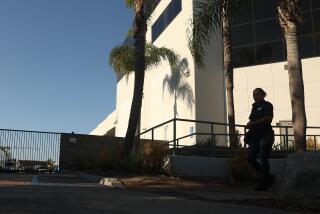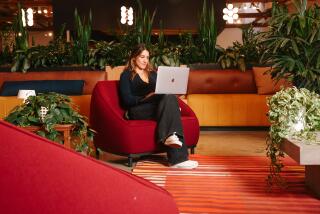Women want the office to be warmer. Science now backs them up

L.A. Times Today airs Monday through Friday at 7 p.m. and 10 p.m. on Spectrum News 1.
- Share via
What’s the perfect office temperature?
Everyone you ask will have a different answer. For some people, an office climate bordering on frosty is ideal; for others, anything below subtropical necessitates a blanket, fingerless gloves and an illicit space heater.
There’s no one thermostat setting that will make everyone happy. But in a new study, USC researchers offer the temperature that facilitates optimal productivity.
In a study published in the journal PLoS ONE this month, Tom Y. Chang, an associate professor of finance and business economics at the USC Marshall School of Business, and his team looked at how male and female students performed on math, verbal and cognitive tasks at temperatures ranging from 61 to 91 degrees Fahrenheit.
The findings: Women performed better at temperatures between 70 and 80 degrees, whereas men performed better at temperatures below 70. However, women were more negatively impacted by colder temperatures than men were by warmer ones.
So, if an office manager is looking to maximize workplace productivity, where should the thermostat needle land?
“I’m cringing a little bit to say this,” Chang said. “75 degrees to me is boiling. That’s hot. I’m very warm at 75. But in a gender-balanced office environment, our results suggest that something like 75 degrees might be the optimal temperature to have for optimal productivity.”
This is not the first time the office thermostat battle has made headlines. A 2015 study published in Nature indicated office temperatures are generally set based on an empirical thermal comfort model from the 1960s, when the workforce was much more predominantly male.
In other words: Offices tend to be climate-controlled to men’s preferences, which we now know comes at the expense of women’s comfort and productivity.
A rash of articles about how the office AC is sexist followed, along with a College Humor video cataloging the very real ordeal of “women’s winter” in workplaces across America.

In rebuttals, the argument was made that this was a dress-code issue, not a thermostat one: Men traditionally wear suits to work, while women’s workwear tends to be lighter and more adaptable to the weather. But without meaning to, this new study controlled for that, Chang said: Study participants were students, the vast majority of whom were dressed in weather-appropriate casual clothing. So even when you control for the dress code, men and women still have different temperature preferences.
The results came as a surprise to Alison Green, author of the advice site Ask A Manager, who’s received a number of letters over the years asking her to weigh in on the thermostat wars. She said in the past her advice has been to err on the side of chilly: It’s easier to put more clothes on and warm up than it is to remove them and cool down in a professional environment.
But hearing the results of the USC study, “now I’m questioning my advice,” she said, “especially given the gender divide on this.”
The Occupational Safety and Health Administration does not have a firm ruling on office temperatures: It advises workplaces to be between 68 and 76 degrees, a fairly wide range. Assuming your workplace isn’t dangerously hot or cold — if your employees are risking frostbite or heat stroke, obviously, changes need to be made — Green said managers have some options for helping people acclimate to the indoor climate.
Try to allow space heaters or fans if it’s safe to do so, she said, and loosen up on the dress code when people are trying to stay comfortable at work. Another option is to rearrange seating, so that the coldest person in the office isn’t positioned directly under a roaring AC vent, and the warmest isn’t baking next to your sunniest window.
In general, she said, as offices across the workforce relax dress-code standards, more people should be able to find clothing options so they can focus more on work and less on the mercury wars. In the meantime, science says to set the thermostat in the mid-70s.
More to Read
Inside the business of entertainment
The Wide Shot brings you news, analysis and insights on everything from streaming wars to production — and what it all means for the future.
You may occasionally receive promotional content from the Los Angeles Times.











